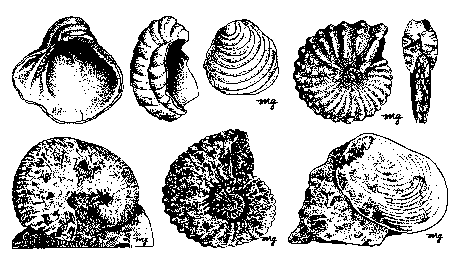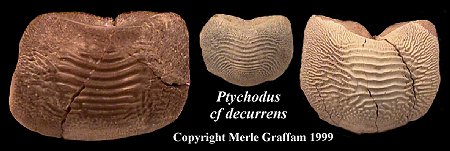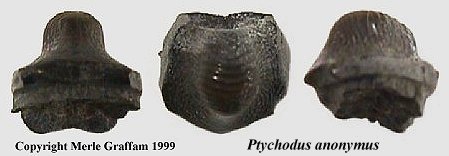| |
Unlike many Cretaceous marine environments of the United States, the shark fauna
of the Tropic Shale of south-central
Utah has been poorly documented. Although it's premature to attempt a faunal page on this formation,
it is certainly useful to share observations and solicit opinions. The abundance of ptychodid teeth
provides an excellent starting point for cyber-discussion. The authors request any comments, criticism
and/or additional information as it relates to the Tropic Shale or the accompanying specimens.
Cretaceous Marine of Utah
When the Mesozoic of Utah is brought to mind, it's the dinosaurs that meander through the foreground of
one's mental diorama. If paleontology is an obsession or profession, the dinosaurs may share this
Cretaceous image with multituberculates, marsupials and flowering plants. Buried in the background
would be the marine environment of the southeastern portions of the state - the realm of mosasaurs,
plesiosaurs and sharks.
This portion of the state harbored a fauna similar to that found elsewhere in the Inland Cretaceous Seaway.
The oldest Cretaceous unit is the Dakota Formation (unconformably overlying the Entrada Formation).
these sandstones yield the fossils of marine invertebrates and vertebrates as well as dinosaurs and
mammals. Lying above are the purely marine sediments of the Tropic Shale with a rich invertebrate and
vertebrate fauna. The Mesaverde Group
occupies the remainder of the Cretaceous. Lying above the Tropic Shale are the towering cliffs of the
Straight Cliffs Formation. These coal-bearing (John Henry & Smoky Hollow members) sandstones
and shales yield a diverse, near-shore marine fauna including invertebrates,
fishes, amphibians, reptiles, pterosaurs and terrestrial material (dinosaurs and mammals). The sandstones
and shales of the next component of the group, the Wahweap Formation, produces a similar fauna, however
placental mammals now appear. The sandy shales of the upper most formation, the Kaiparowits, also includes
sharks, batoids, bony fishes, amphibians, turtles, lizards and crocodiles but the fauna now includes birds
and a full range of mammals (multituberculates, marsupials and placentals).
Tropic Shale
The Tropic Shale is ascribed to the Greenhorn Cyclothem, which correlates with portions of the Mancos shale
in Colorado and the Carlile Shale of Kansas. These deposits from the western margin of the Inland Cretaceous
Seaway would be relatively deep-water, offshore deposits dating to the late Cenomanian through Middle Turonian.
At the discussed locale a 10 foot layer of the Dakota Sandstone is exposed. These sediments are characterized
by abundant Exogyra (Costagyra) olisiponensis SHARP valves (4-5 inches in diameter).
Sandwiched between the Dakota and the Tibbet Canyon Member of the Straight Cliffs Formation is several hundred
feet of blue-gray Tropic Shale. The Tropic Shale stratigraphy can be seen in cliff faces, but it is the undulating mounds
of eroded material that is collected. These "dunes" originate from the lower 50 or so feet of the shale, and to make
sense of these weathered bentonitic silts with their scattered limestone nodules and gravel, their original stratigraphic
positions must be understood.
In the cliffs, above the Dakota, can be seen three nodule layers, each about five to ten feet apart. Sediments associated
with the lowest layer produce few fossils, and those, mostly primitive-looking, thick-shelled oysters. On the dunes,
these shales can be identified by the presence of low-quality septerium crystals. The middle nodule layer is more
fossiliferous, yielding Pycnodonte newberryi, gastropods, baculites, ammonites, bivalves, etc. The shales
associated with the upper nodule layer are very productive - full of invertebrates such as baculites, bivalves, turritella,
ammonites, razor clams, etc. Just above this last layer is found the expansive beds of Pycnodonte newberryi
(STANTON), a Cretaceous oyster. The shales originating from above these Pycnodonte
beds become the undulating dunes and mini-buttes of decomposed shale which yield shark teeth and bone.
Note on invertebrates. The common baculite of the shale is Sciponoceras gracile SHUMARD.
Ammonoids include Metoicoceras geslinianum d'ORBIGNY,
Allocrioceras annulatum SHUMARD,
Euomphaloceras septemseriatum CRAGIN and
Yezoites delicatulus. In addition to the noted oysters, Inoceramus spp are present as is
Turritella whitei STANTON.
 |
Fig. 1 - Tropic Shale Invertebrates
[top left] Pycnodonte newberryi
[topright] Metoicoceras geslinianum, 3.5 " diameter
[bottom left] Yezoites delicatulus
[bottom center] Euomphaloceras septemseriatum
[bottom right] Inoceramus sp
Tropic Formation, Kane County, Utah
Copyright Merle Graffam 1998 |
Elasmo-Fauna
A great number of complete and fragmentary shark teeth have been collected from this locale.
Of the 700 teeth found by the senior author, the vast majority are ptychodid and of them, 80% are small with crowns
that range from low to high. The timeframe associated with the Tropic Shale would permit a number
of species to be represented. Those attributed by Welton & Farish (1993) to the Texas fauna that
have been found in the Tropic Shale include:
Ptychodus anonymus WILLISTON 1900 (Cenomanian-Turonian),
P. decurrens AGASSIZ 1843 (Albian-Cenomanian),
P. occidentalis LEIDY 1868 (Cenomanian-Turonian),
P. polygyrus AGASSIZ 1839 (Turonian) and
P. whipplei MARCOU 1858 (Turonian-Coniacian).
Ptychodus cf decurrens
Welton & Farish include two species in the Texas fauna that have transverse ridges which become
bifurcated laterally and continue to the margin -- P. decurrens & P. occidentalis.
Both of them were listed as rare, with the former attributed to the Albian-Cenomanian and the other
other, Cenomanian-Turonian.
Other than time, the height of the crown was the most distinguishing characteristic -- P. decurrens
was referred to as low-crowned and P. occidentalis as high-crowned.
 |
Fig. 2 - Ptychodus cf decurrens AGASSIZ 1843
Widths from left to right: 3.7, 1.9 and 3.2 cm
Tropic Formation, Kane County, Utah |
The Tropic Shale yields numerous teeth which have this ridge design, but which have crowns of
medium height (Fig. 3). Welton & Farish illustrations depict P. decurrens as having ridges which are
stronger and less numerous than P. occidentalis. Referring to Figure 2, the 3.7 cm tooth is
more P. decurrens-like and the 1.9 cm tooth closer to P. occidentalis.
Welton & Farish have P. decurrens as the species with smaller teeth (to 1.5 cm) and
P. decurrens as the larger (to 3.0 cm). The larger teeth in Figure 2 fall well out of the range
of P. occidentalis.
 |
Fig. 3 - Ptychodus cf decurrens AGASSIZ 1843
3.2 cm
Tropic Formation, Kane County, Utah |
As can be seen, the Tropic Shale yields teeth which compare reasonably well with P. decurrens
and at times, P. occidentalis as well. These variations may reflect a different species, but
more likely, a variation (regional, chronogenetic, ontogenetic) of the P. decurrens design.
Ptychodus cf anonymus
As noted earlier, the vast majority of Tropic Shale ptychodid teeth are small and the
crown heights range from low to high. Welton & Farish included two species in the Texas fauna that
fall into this loose description - P. anonymus and P. whipplei. In general, the teeth of
P. whipplei have higher and labio-lingually compressed crowns. P. anonymus teeth
range from low to high, based on file position, and when viewed laterally, the crown is deeper.
P. anonymus (to 14 mm) was noted as common in Cenomanian-Turonian sediments and
P. whipplei (to 29 mm) as abundant in Turonian-Coniacian exposures.
 |
Fig. 4 - Ptychodus anonymus WILLISTON 1900
Portion of root missing, specimen measures:
height 1.2, depth 1.3, width 1.4 cm
Tropic Formation, Kane County, Utah |
The Tropic Shale specimen in Figure 4 has an unusually high crown, but not the highest from the locale.
There are 12 transverse ridges that meet the crown margin and become almost granular below.
(Unlike P. anonymus, Welton & Farish indicate that the transverse ridges of P. whipplei
usually do not meet the margin.) The crown of this specimen is higher or more laterally compressed
than normal in P. anonymus.
Ptychodus sp
Compared with other Tropic Shale ptychodids, this is a monster tooth. The ridge pattern should be
diagnostic, but this tooth compares poorly with examples provided by Welton & Farish. Those
authors included a single species (Turonian) with very large teeth and a low crown - P. polygyrus.
 |
Fig. 5 - Ptychodus sp
Width: 4.2 cm
Tropic Formation, Kane County, Utah |
References
Anderson, R., 1999. Grand Staircase. Natural History, 108(1): 66-71
Baars, D., 1972. The Colorado Plateau, A Geologic History. University of New Mexico Press, Albuquerque.
Callaway, J. & Nicholls, E., 1997. Ancient Marine Reptiles. Acadamic Press, San Diego, California.
Chronic, H., 1990. Roadside Geology of Utah. Mountain Publishing, Missoula, MT. 326pp.
Doelling, H. & Davis, F., 1989. The Geology of Kane County, Utah. Utah Geological and Mineral Survey,
Bulletin 124, SLC, Utah.
Hill, L., 1997. Learning from the Land, Grand Staircase-Escalante National Monument Science Symposium
Proceedings. Bureau of Land Management, Southern Utah University.
Hintze, L., 1988. Geologic History of Utah. Brigham Young University Geology Series, Special Publication 7,
Provo, Utah.
Pollock, G., Cobban, W. & Dyman, T., 1997. Paleontologic Inventory of Dominantly Marine and
Brackish Water Late Cretaceous Rocks in the Grand Staircase-Escalante National Monument.
USGS Bulletin, Bryce Canyon Natural History Association, Research Report 97-1, Bryce Canyon, Utah,
pre-publication manuscript copy, 1997?
Stokes, W., 1988. Geology of Utah. Utah Museum of Natural History, University of Utah and Utah
Geological and Mineral Survey, Department of Natural Resources, Salt Lake City, Utah.
For paleo-maps of the Southwestern US, visit Dr. Ron Blakey's excellent webpage
Cretaceous Paleogeography, Southwestern US
If you can provide feedback or help us with this effort, contact:
Merle Graffam or
Jim Bourdon
|